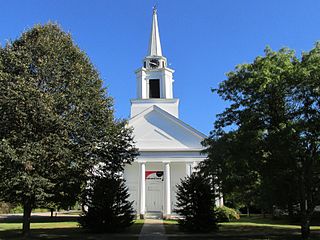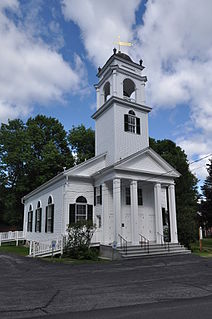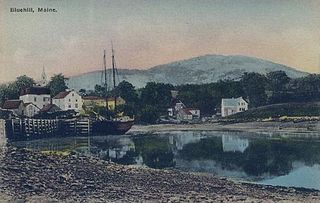Related Research Articles

The Harpswell Meetinghouse is a historic colonial meeting house on Maine State Route 123 in Harpswell, Maine. Built in 1757-59 to provide space for both religious services and town meetings, it is a little-altered and well-preserved example of a once-common form, and is the oldest such surviving building in the state of Maine. It was designated a National Historic Landmark in 1968.

Preston City is a village and the original town center of the town of Preston, Connecticut. The core of the village around the junction of Old Northwest Road and Route 164 is designated as the Preston City Historic District, a historic district that is listed on the National Register of Historic Places. The district is located along Old Shetucket and Amos Roads, which, prior to the 1930s, were major thoroughfares.

The Sheffield Plain Historic District encompassing the original 18th-century village center of Sheffield, Massachusetts. The linear district extends southward about 0.5 miles (0.80 km) from the junction of United States Route 7 and Cook Road, where the original town common is located. The district was primarily developed in the mid-18th and early 19th centuries. It was listed on the National Register of Historic Places in 1988.

The Upper Historic District is a historic district encompassing the historic center of Washington, Massachusetts. Centered on the junction of Washington Mountain Road and Branch Road, the town center flourished from the town's establishment in the 1750s until the center of the town's business moved closer to the newly lain railroad in the 1830s. The district includes the old town hall, cemetery, common, and pound, as well as a number of residences. A meeting house (church) and schoolhouse once stood in the area, but the 1792 church was destroyed by lightning in 1859, and the schoolhouse is no longer extant. The district was added to the National Register of Historic Places in 1987.

The Pelham Town Hall Historic District encompasses the remaining municipal portion of the center of Pelham, Massachusetts as laid out between 1738 and 1743. It includes the Old Town Hall, built in 1743, which is claimed by the town to be the oldest continuously used town hall in the United States. It also includes the 1843 Greek Revival Congregational church, and the town's first cemetery, founded in 1739. The district was listed on the National Register of Historic Places in 1971.

The Chester Center Historic District is a historic district encompassing the historic center of Chester, Massachusetts. The area was first laid out by Chester's first settlers in 1763. It remained the center of commerce and civic life in the rural agricultural community until railroads were built in other areas of the town in the 1840s. The village center declined in importance as economic activity moved to areas more readily accessible to the railroad, and the town hall was eventually moved to Chester Factories. The district includes properties on Skyline Trail near the intersection of Bromley and Lyman Roads, and features Greek Revival, colonial, and Federal architecture. It was listed on the National Register of Historic Places in 1988.

The Weathersfield Center Historic District encompasses a small cluster of buildings and a historic site at the geographic center of the town of Weathersfield, Windsor County, Vermont, United States. It includes the town's second church building, the home of its first settled minister, and an early stone animal pound. It was listed on the National Register of Historic Places in 1980.

The First Baptist Church is a historic church building on High Street, off Maine State Route 172 in Sedgwick, Maine. It was designed in Greek Revival style by architect Benjamin S. Deane, based on published drawings by Asher Benjamin, and built in 1837 for a congregation founded in 1805. It is one of coastal Maine's finest Greek Revival churches, and was listed on the National Register of Historic Places in 1973.

Comins Hall, also known as the East Eddington Public Hall and the Eddington-Clifton Civic Center, is a historic social and civic meeting hall at 1387 Main Road in Eddington, Maine. Built in 1879, it has since then served as the town's only major social and civic meeting space, hosting town meetings, dances, dinners, Grange meetings, and traveling performers. It was listed on the National Register of Historic Places in 2004.

The Colburn Park Historic District encompasses the heart of Lebanon, New Hampshire. It consists of Colburn Park, a large rectangular park in the center of the city, the buildings that are arrayed around it, and several 19th century buildings that are immediately adjacent to those. The district covers 12 acres (4.9 ha), and was listed on the National Register of Historic Places in 1986.

The Main Street Historic District of Fryeburg, Maine, encompasses the growth of the town's principal village between about 1800 and 1935. It extends along Main Street, from Woodland Street in the north to Portland Street (SR 5 and Maine State Route 113) in the south, and includes forty primary buildings on 55 acres (22 ha). The district was listed on the National Register of Historic Places in 1991.

The Waterford Historic District encompasses the well-preserved historic town center, also known as Waterford Flat, of the rural inland town of Waterford, Maine. Settled in 1775, the town grew around a site where Kedar Brook empties into Keoka Lake. The oldest surviving building, the Lake House, dates to 1797, while most of the houses were built before 1850. Prominent public buildings include a series designed by John Calvin Stevens, including the Knight Library, Wilkins Community Hall, and First Congregational Church. The district was listed on the National Register of Historic Places in 1980.

The Blue Hill Historic District encompasses the historic village center of the town of Blue Hill, Maine. The village, established in 1762, is a well-preserved collection of buildings, many of them built before 1840. Most of the older buildings are residential in character; the modest collection of commercial and civic buildings were mostly built between 1880 and 1940. The district was listed on the National Register of Historic Places in 1980.

The Dudley's Corner School House is a historic former school and civic building at the junction of Rosies Court and Dudley Corner Roads in Skowhegan, Maine. With a possible construction date as early as 1804, was Skowhegan's first site for town meetings and elections, also seeing use as a school and church. It was used primarily as a school between 1849 and 1921, and has been used since then by community groups. The modest Greek Revival building is the least-altered of Skowhegan's surviving 19th-century district schools, and was listed on the National Register of Historic Places in 2002.

The Old Town House is the town hall of Parsonsfield, Maine. Located on Merrill Hill Road, the 1834 Greek Revival building has served as the town's main civic building for more than 150 years. It was listed on the National Register of Historic Places in 2002.

The Dixmont Town House is a historic civic and community building at 702 Western Avenue in Dixmont, Maine. Built in 1836, it is one of a few well-preserved early town halls in Maine that served a strictly civic purpose. It was used by the town for its town meetings until 1952, and has been restored to an early 20th-century appearance. It was listed on the National Register of Historic Places in 2014.

Corinth Village, also known as the Skinner Settlement Historic District and West Corinth, is an early 19th-century rural crossroads village in the small town of Corinth, Maine. Centered at the junction of Ledge Hill and West Corinth Roads, the village includes a number of buildings constructed before 1850, one of which may have been the first frame structure built in the area. The village was listed as a historic district on the National Register of Historic Places in 1973.

The Standish Corner Historic District encompasses a collection of five early farmhouses in the village of Standish Corner in southeastern Standish, Maine. All five houses were built in the late 18th or early 19th century, and the assemblage are all that survive of the town's original early center. The district was listed on the National Register of Historic Places in 1993.

The Dresden Town House is a historic civic and social venue at 391 Middle Road in Dresden, Maine. Built in 1859 and enlarged in 1904, it has housed town meetings for many years, as well as serving as a polling place and venue for social events such as dances and community group meetings. It was listed on the National Register of Historic Places in 2000.

The Old Town House, also known as the Union Town House, is a historic government building at 128 Town House Road in Union, Maine. Built in 1840, it served the town for many years as its town hall, and as one of its major social venues. It is now owned by the local historical society, which operates it as a community meeting place. It was listed on the National Register of Historic Places in 2001.
References
- 1 2 "National Register Information System". National Register of Historic Places . National Park Service. July 9, 2010.
- ↑ "NRHP nomination for Sedgwick Historic District". National Park Service. Retrieved 2015-04-06.